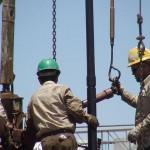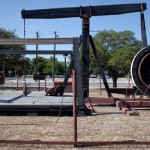Shale for Sale: Looking Beyond the Buzz in the Cline
 Right now, there’s a lot excitement over different shale formations across Texas and across the country. But along with excitement, there sometimes comes hype.
Right now, there’s a lot excitement over different shale formations across Texas and across the country. But along with excitement, there sometimes comes hype.
First there was the Barnett near Fort Worth and Pennsylvania’s Marcellus. In South Texas you’ve got the Eagle Ford. North Dakota taps the Bakken. It seems like everywhere you look, drillers are finding shale formations that might be the “next big thing” for the American energy industry. (Shale formations are layers of rock that companies can sometimes drill for oil and gas using hydraulic fracturing, or fracking.) Recently the “next big thing” being touted is the Cline Shale in the Permian Basin of West Texas.
The Cline Shale lies more than 9,000 feet underground and many in the energy business expect it to bring the next oil and gas boom to West Texas.
But how big of a boom?
The entire formation of the Cline Shale spans nearly 10,000 square miles and could have up to 3.6 million barrels of obtainable oil per square mile.
But not everybody is convinced. Art Berman is an oil and gas geological consultant and prominent critic of some drilling companies.
“The analogy that I like to use is the traveling circus,” Berman said. “Why does a circus have to travel? Well, because after it’s been in the town for a couple days, or a week or so, all the townspeople begin to understand that the bearded lady doesn’t really have a beard!”
Berman said each new shale discovery serves as a way for some companies to inflate their stock values. So all that hype might have to do more with Wall Street than what’s in the ground. But it’s not just industry critics that are tamping down enthusiasm over the Cline.
Ben Shepperd, President of the Permian Basin Petroleum Association, says there’s great potential in the Cline Shale.
But, “number one, it’s not going to happen over night,” he said. “The operating community hasn’t identified [or] cracked the code on how to access it routinely,” he added.
By code, Sheppard was referring to the geology of the region and the hydraulic fracturing techniques necessary to maximize the recovery rates.
Then there are those figures about the millions of barrels of oil that could be deep underground. They come from estimates from Devon Energy. Chip Minty, a spokesperson for the company, says those estimates were actually based on best case assumptions, scenarios where “everything works out perfectly.”
“And we all know that nothing ever works out perfectly. Best case scenarios are highly unlikely. So we are approaching this realistically,” Minty said.
Chesapeake Energy, another big oil and gas player, actually sold most of its holdings in the Cline Shale last year. It has no plans to develop the land it still owns, according to a spokesperson. Yet West Texas communities are still abuzz over the Cline’s potential, and local companies are turning that enthusiasm into profit.
Blake Templeton runs a group called LubbockInvest.com. His company has used the Cline to generate interest in real estate investment in the region. He says business is booming. StateImpact Texas asked Templeton what would happen if the Cline doesn’t deliver on its promises.
“In a boom and bust oil town, the paradigm shift has shifted, it’s changed. The variables are constants,” Templeton said. “What I would say is you still own a tangible asset.”
It would just be worth significantly less if the projected boom ends up going bust.

